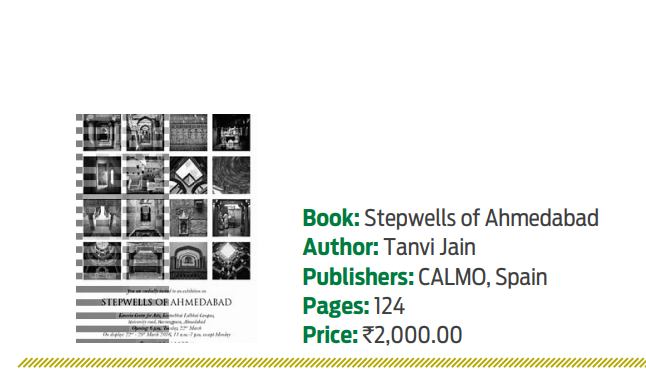Stepwells, a vital source of water for people in ancient India, are merely heritage structures now. As modern techniques overshadow these ancient METHODS, a recent exploration into Ahmedabad’s stepwells highlights their historical significance, urging a revival of these sustainable practices for a climate-resilient future.

In the face of climate change, India’s forgotten stepwells, once architectural marvels and vital water sources, hold valuable wisdom. As modern techniques overshadow these ancient traditions, a recent exploration into Ahmedabad’s stepwells highlights their historical significance, urging a revival of these sustainable practices for a resilient future.
Stepwells have been an integral part of ancient India. They were not only a source of water but also served as religious centres and architectural marvels created by known and unknown people many centuries ago. Modern India, promoting various new technologies, has indeed forgotten the art of digging stepwells and their importance—a sad commentary on a fast-progressing nation. Embracing modernism or acquiring new technologies is not wrong, but forgetting our rich cultural past is surely not advisable. By turning our backs on the stepwells and adopting tube wells for convenience, we are neglecting an essential part of our heritage. A young architect from Indore, Tanvi Jain, now living in London, gifted me a little book on this topic some time ago. I was reminded of it when I recently saw two impressive stepwells in the quaint Sitamau Palace in the Mandsaur district of Madhya Pradesh. Many years ago, I had seen a well-maintained stepwell in Neemuch, bordering Rajasthan. Tanvi and her colleagues Priyanka and Aashini Sheth produced this brilliant book as part of collaborative research into the making of the beautiful wells of Ahmedabad. This historic city, a large portion of which is now a ‘heritage city’ declared by UNESCO, has a fascinating collection of stepwells.
In all, 17 heritage wells have been documented—a Herculean task indeed for the young students. The superb documentation of these wells, known as ‘vaav’ in Gujarati, was done by a team of about 8–10 architecture students. The appreciable collaborative was launched by Riyaz Tayyibji of Anthill Design in 2015. The book is a sequel to exhibitions of photographs and drawings of the city’s stepwells, showcased at the Kanoria Centre of Arts in Ahmedabad, with successive iterations at Sabarmati Ashram. Later, it was displayed at the famous Yale School of Architecture in New Haven and its online version at the Cooper Union in New York, among other places.
The book states, “The research initiative intends to raise awareness about the larger concerns around water, settlement patterns, heritage, and social relationships tied to them.” In his foreword, S Vishwanath, a Bengaluru-based water expert, says, “Since the Harappan civilisation, as early as 3000 BC, the Indian subcontinent has depended on aquifers, groundwater, and wells for a large part of its water requirements. Every third house in Mohenjo Daro had a well.”
The book takes into account traditional water structures in north Gujarat, built by communities who knew their requirements and also the terrain around them so as to build the right kind of tank (lake), a stepwell (vaav), or a kund (pond). Delhi residents are quite aware of the Agrasen Baoli near Connaught Place, but this bouquet of wells will surprise you. “A typical stepwell,” write the authors, “is a subterranean building that consists of a large, open well shaft attached to a long, stepped corridor sandwiched between retaining walls. Descending several stories from ground level to the aquifer, the stepped corridor alternates between light and shade cast by pillared galleries on each consecutive landing, providing much-needed respite from the region’s hot, dry climate.”
The book carries beautiful pictures detailing the architectural features of a stepwell. For students, it contains fine drawings of the wells, their measurements, and other details in maps and diagrams, making it a valuable collection for one’s library. The Ankol Mata vaav in Davad village dates back to the 11th century, while the two other later-day stepwells, namely Rudabai vaav in Adalaj and Bai Harir vaav in Asarwa, were built in the 15th century and are considered the most architecturally elaborate ones. Rudabai Vaav, an Archaeological Survey of India (ASI)-protected monument, attracts international tourists. “Stepwells, in sync with ponds and tanks, sustained the nexus between Ahmedabad’s urban core, its surrounding settlements, and centuries of evolving cultivation, craft, and trade,” says Tanvi Jain while talking to Urban Update.
The book tells us that when the British colonial regime took over Ahmedabad in 1817, the use of wells and stepwells was actively discouraged, and a municipal commission was established to undertake civic projects, including the provision of water to citizens. While some earlier history of the city is also mentioned in the book, the authors inform us that when the state-administered piped water and sewage system was launched in 1849, it replaced traditional ways of sourcing water in traditional households and communities as the primary stewards of water provision and sustenance.
It was in 1411 that Sultan Ahmad Shah, ruler of the Gujarat Sultanate, built a citadel along the Sabarmati River and established Ahmedabad, now a sprawling modern city trying to compete with the Maharashtra capital, Mumbai, in every possible manner. With growing demand for water and anthropogenic pressures, the use of mechanised pumps, piped water, and tubewells has gradually made these wonderful water structures largely obsolete. Nevertheless, the government must maintain them at any cost, as they represent our glorious culture and ancient wisdom.
